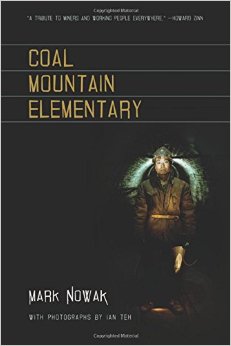Writers Read: Coal Mountain Elementary by Mark Nowak
 Coal Mountain Elementary is a noteworthy example of investigative poetry, which incorporates data and reportage—including statistics, historical documents, news media, interviews, and images—into, most commonly, lyrical and prose poems. Claudia Rankine’s Don’t Let Me Be Lonely: An American Lyric (2004) is a well-known example of the former type as it lets the reader enter the narrator’s mind via the technologically-mediated words, images, and sounds that assault contemporary Americans. Nowak’s Coal Mountain Elementary represents a more scholarly contribution to the genre. It relies on print news stories, court testimony, and lesson plans to convey the normalization of environmental injustice inherent in resource extraction,. The roots of both works lie in poet-activist Ed Sanders’s journalistic approach to poetry, which creatively sequences “fragments of information” in order to provide a critical history (Paul 2009).
Coal Mountain Elementary is a noteworthy example of investigative poetry, which incorporates data and reportage—including statistics, historical documents, news media, interviews, and images—into, most commonly, lyrical and prose poems. Claudia Rankine’s Don’t Let Me Be Lonely: An American Lyric (2004) is a well-known example of the former type as it lets the reader enter the narrator’s mind via the technologically-mediated words, images, and sounds that assault contemporary Americans. Nowak’s Coal Mountain Elementary represents a more scholarly contribution to the genre. It relies on print news stories, court testimony, and lesson plans to convey the normalization of environmental injustice inherent in resource extraction,. The roots of both works lie in poet-activist Ed Sanders’s journalistic approach to poetry, which creatively sequences “fragments of information” in order to provide a critical history (Paul 2009).
Novak did not write Coal Mountain Elementary. Rather, he compiled its contents. The poetry is in how the media are arranged—as a curriculum of coal.
Nowak follows close in Sanders’s shadows, providing a critical history of labor, as motivated by the 2006 Sago Mine disaster, which trapped thirteen coal miners for two days. Only one of them survived. He creates a collage of life and death in the global mining industry by alternating testimonies from the Sago Mine Accident Report and Transcripts, news stories of mining disasters in China, lesson plans supplied by the American Coal Foundation, and photos of American mining towns, and Chinese mine workers. Poet Dan Featherstone views this collection of artifacts as a multimedia response to the question: “What kind of poem would you make out of the lives ad deaths of coal miners throughout the world?” The question is derived from Langston Hughes poem, “Johannesburg Mines”: In the Johannesburg mines/There are 240,000/Native Africans working. /What kind of poem/Would you/Make out of that? /240,000 natives/Working in the/Johannesburg mines.

photo credit: Lisa Arrastia
Much as Hughes arguably did not write this entire poem because the first lines are drawn from the news, Novak did not write Coal Mountain Elementary. Rather, he compiled its contents. The poetry is in how the media are arranged—as a curriculum of coal. The text is organized into three lessons based on the American Coal Foundation instructions for making “coal flowers,” “mining for cookies,” and “history of coal camps and mining towns,” and a coda. The ACF lesson plans were created by coal producers and mining suppliers for K-12 students. In the context of the Sago case testimony and the mining accidents in China, these lesson plans illuminate and critique the recuperation of “public” education into corporate propaganda. Though Novak provides very little historical or social background for the Sago and Chinese mining cases, it is nearly impossible for the reader to miss his argument that coal extraction is far more costly than lessons in art, economics, and history reveal.
Works Cited
Featherstone, Dan. 2011. “What Kind of Poem Would You Make out of That?” Jacket 2, 4 April. Web. http://jacket2.org/reviews/what-kind-poem-would-you-make-out
Paul, Steve. 2009. “An American History, Line by Line: Interview with Ed Sanders.” Poetry Daily 76, 1. Web. http://poems.com/special_features/prose/essay_sanders.php

 Juliann Allison is a feminist scholar, environmentalist, homeschool advocate, yogini, runner, rock climber, mate, and mother of four with a passion for the outdoors. She is Associate Professor of Gender and Sexuality Studies and Public Policy at UC Riverside, and a recent MFA graduate at Antioch University Los Angeles.
Juliann Allison is a feminist scholar, environmentalist, homeschool advocate, yogini, runner, rock climber, mate, and mother of four with a passion for the outdoors. She is Associate Professor of Gender and Sexuality Studies and Public Policy at UC Riverside, and a recent MFA graduate at Antioch University Los Angeles.


